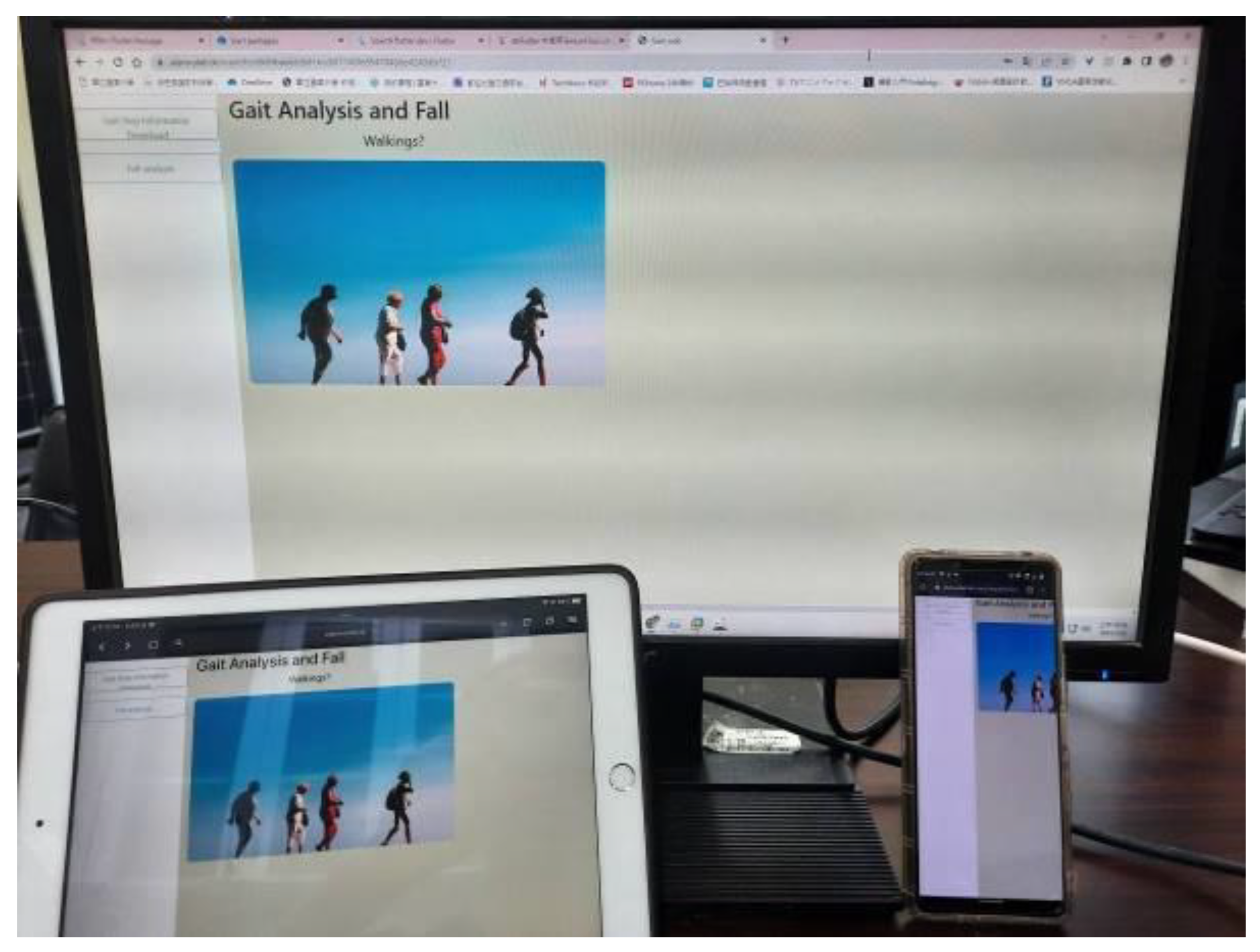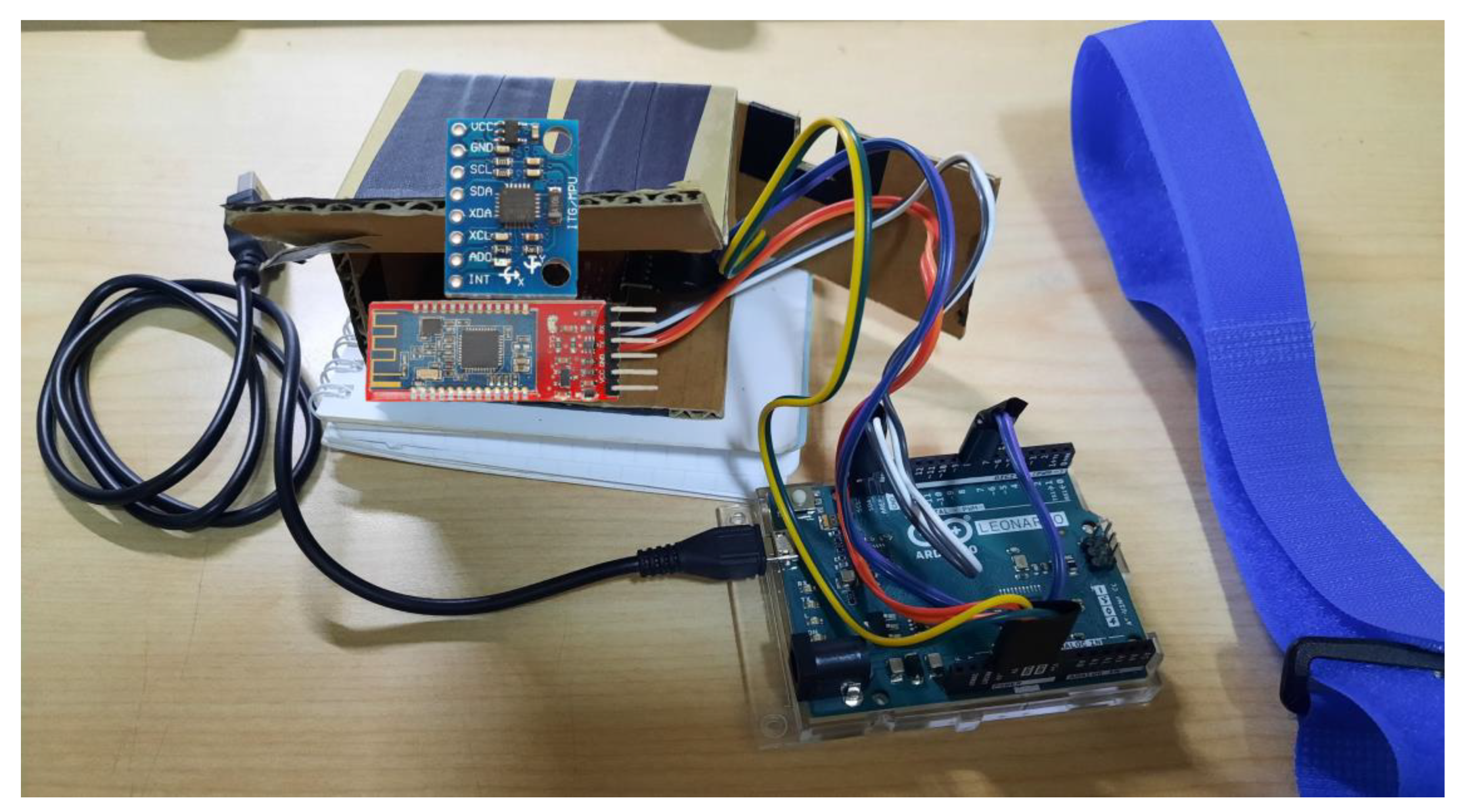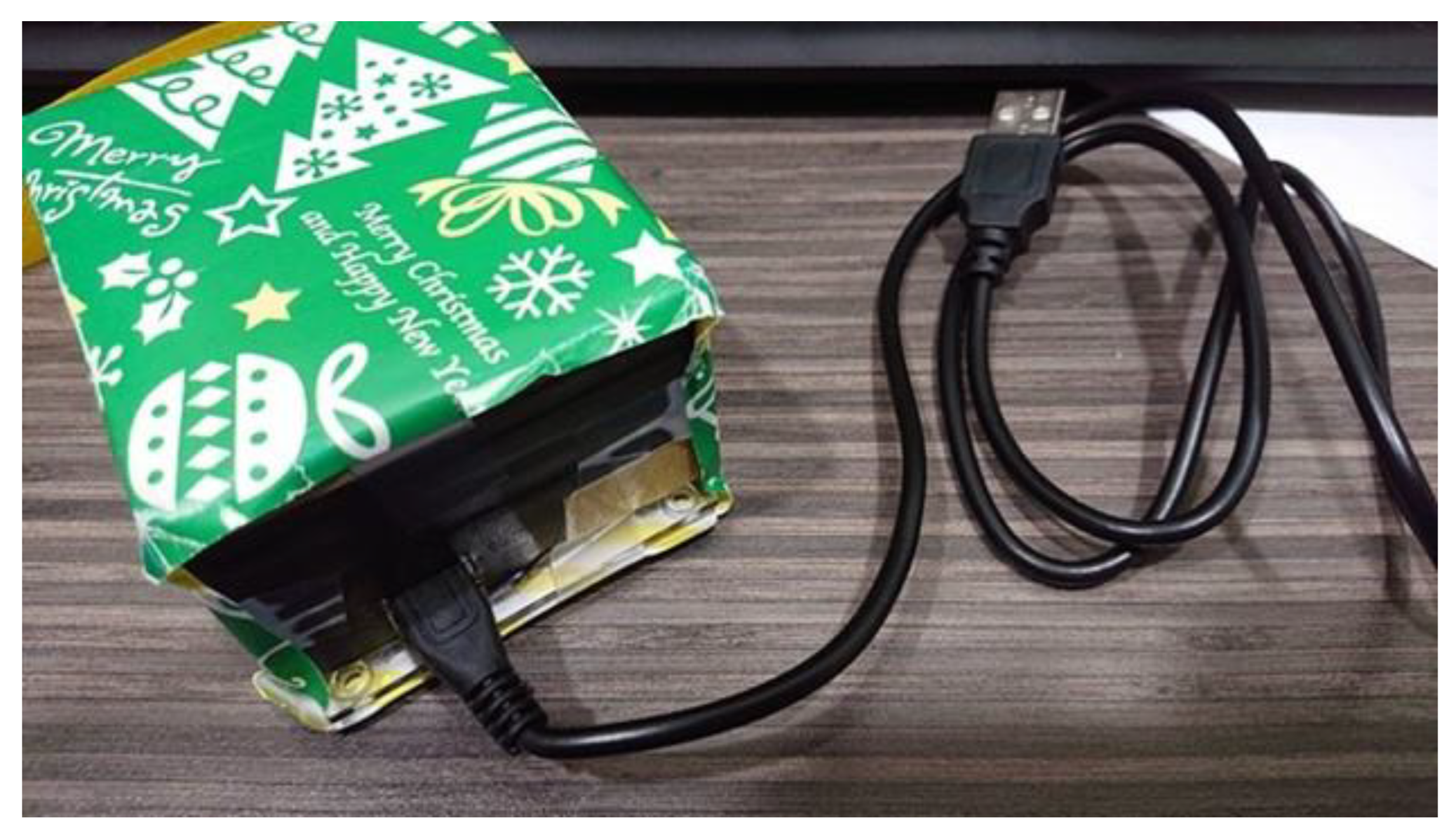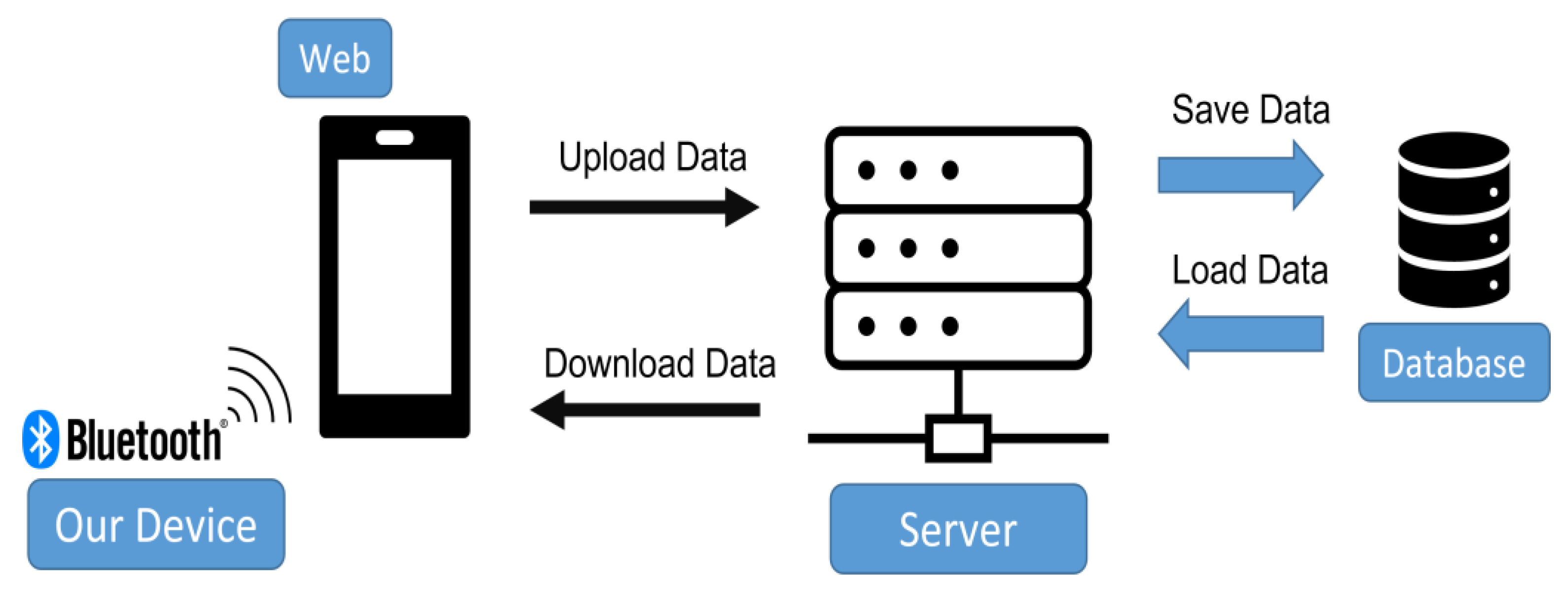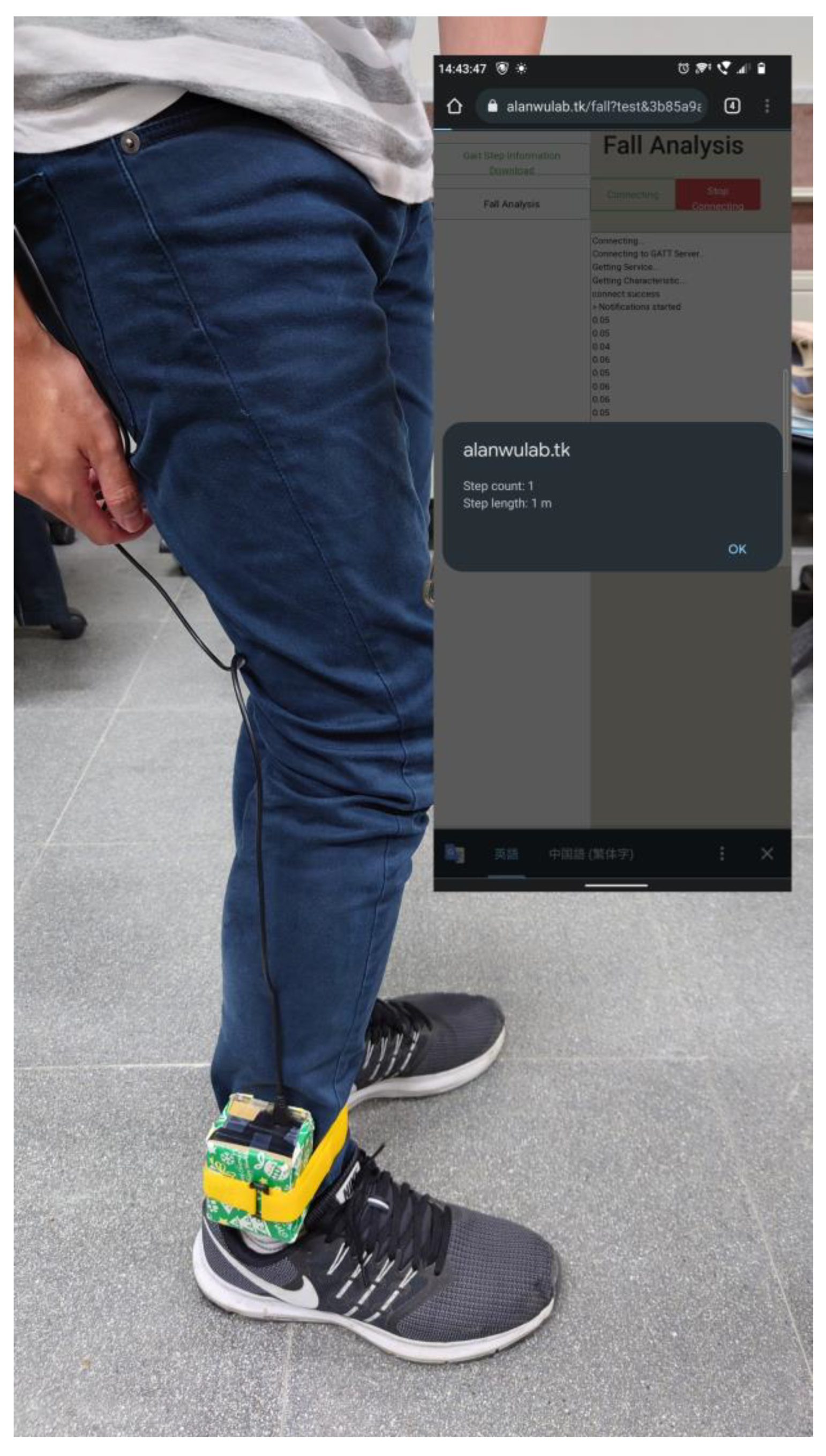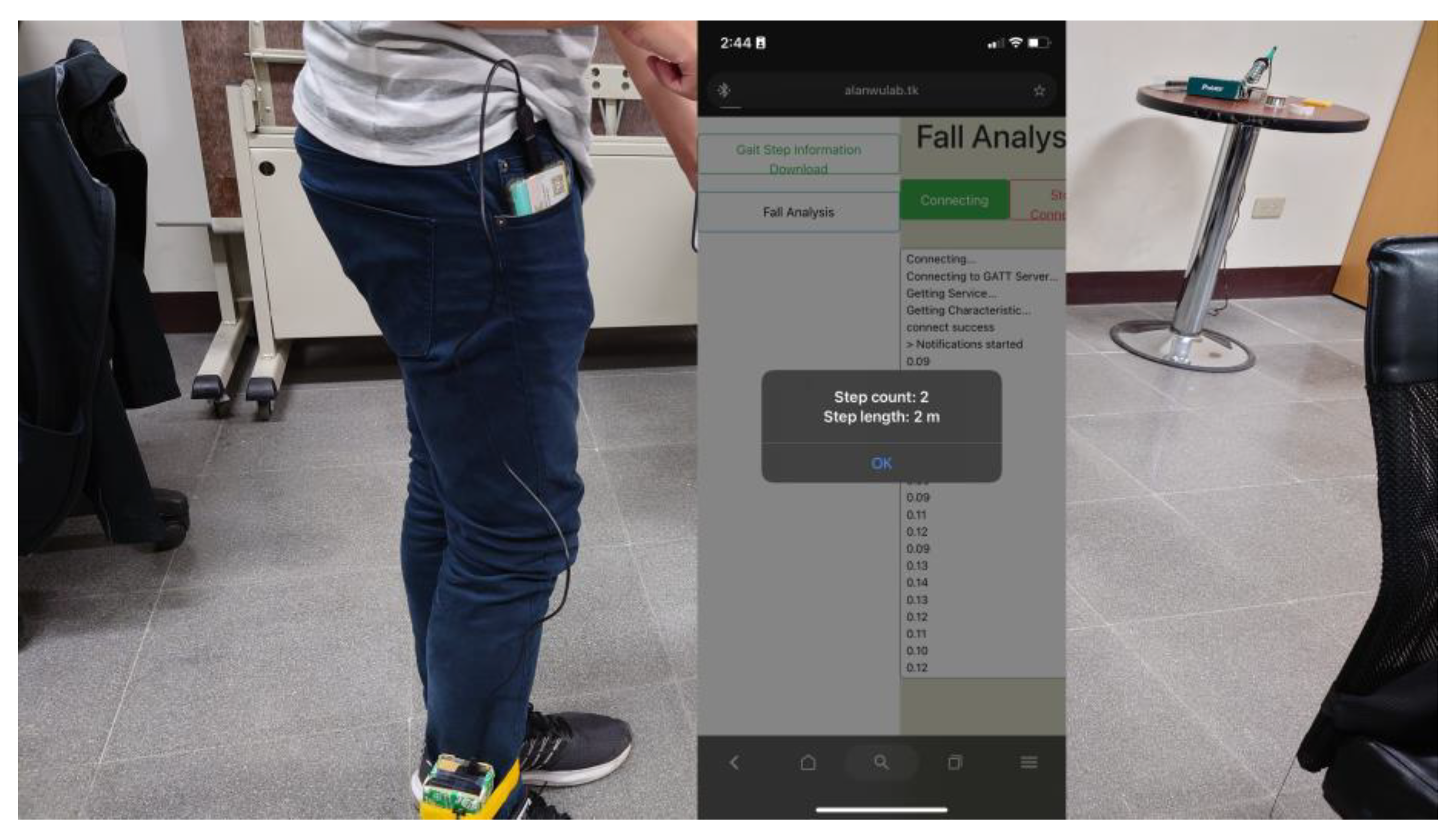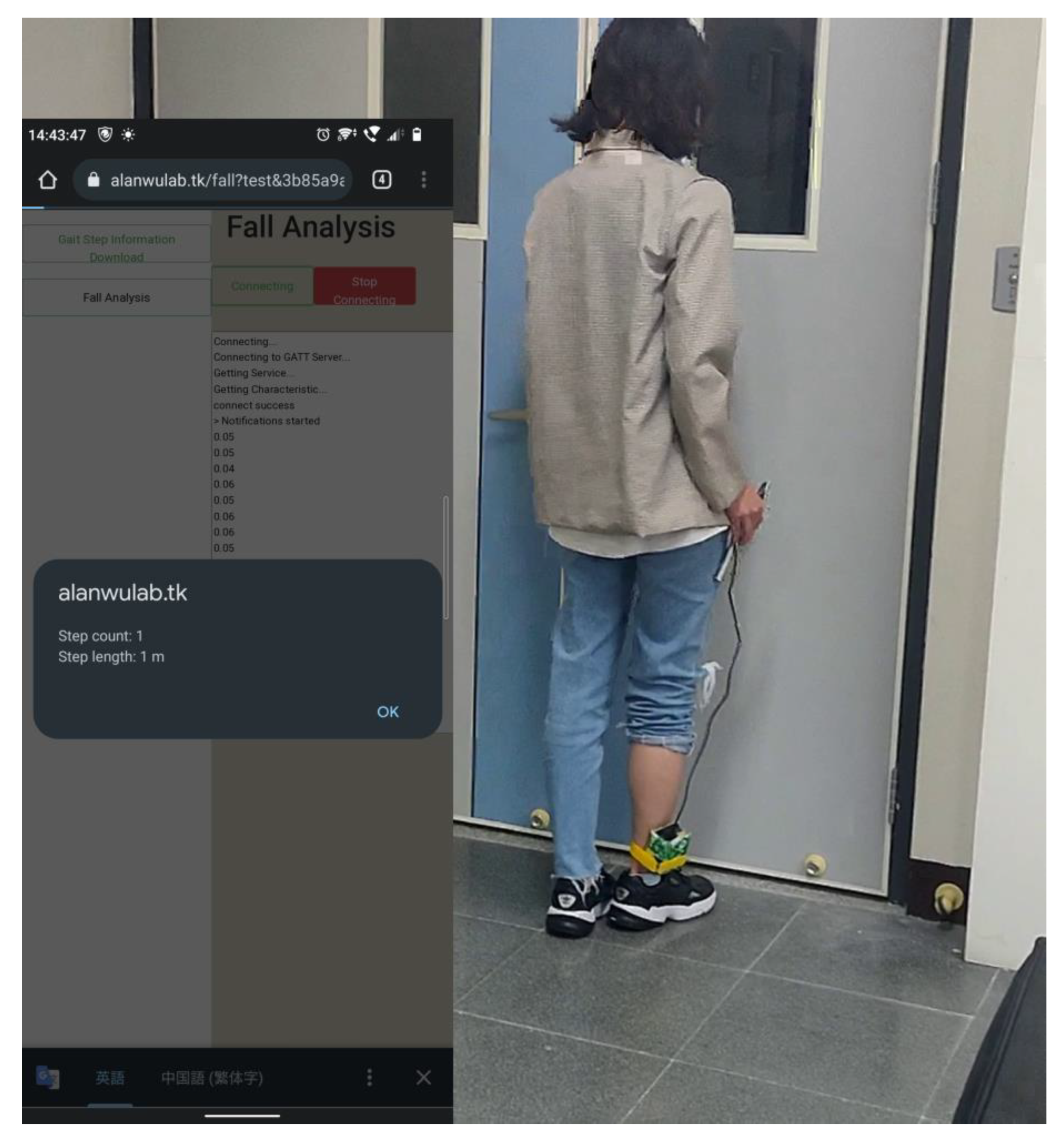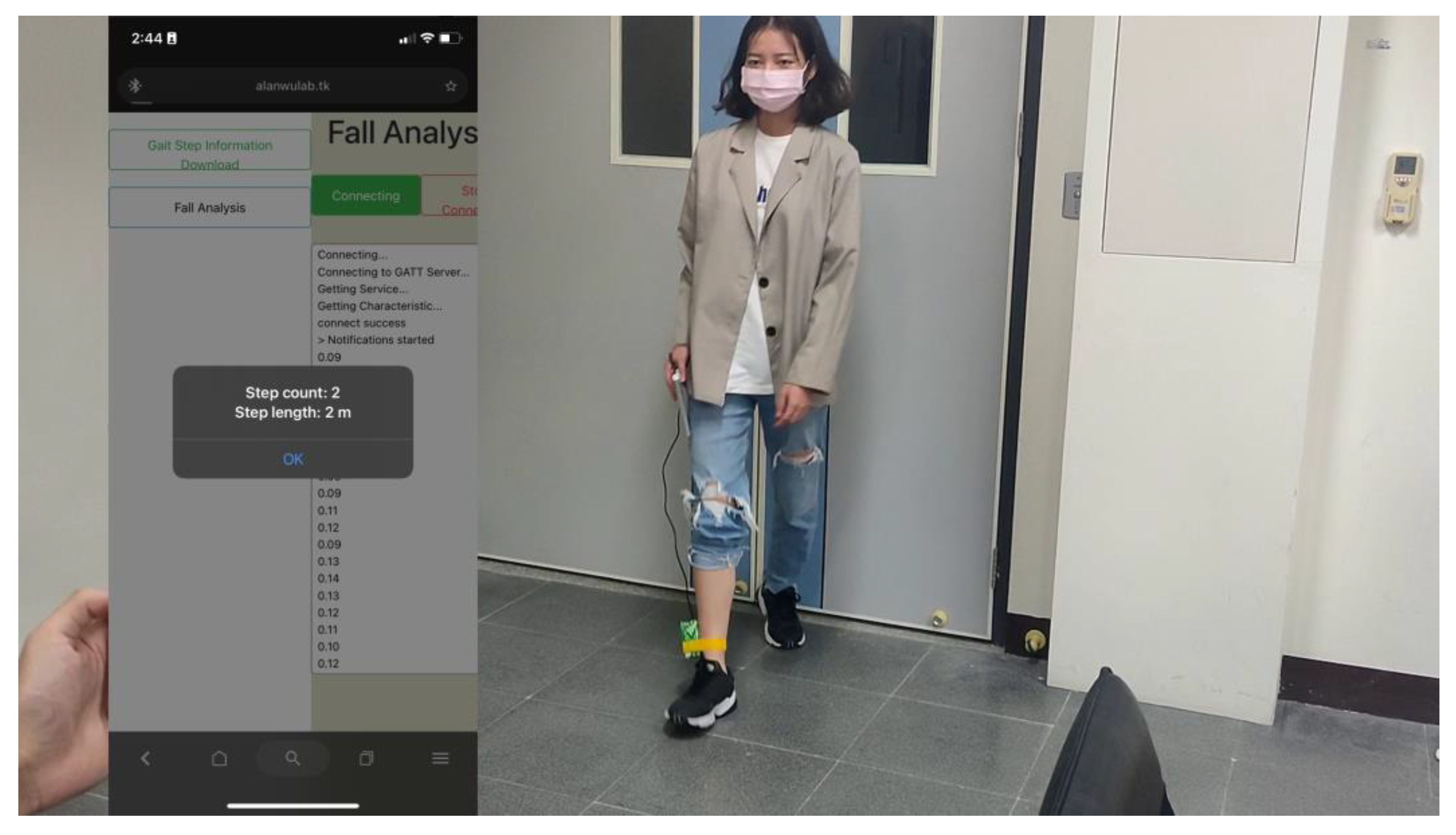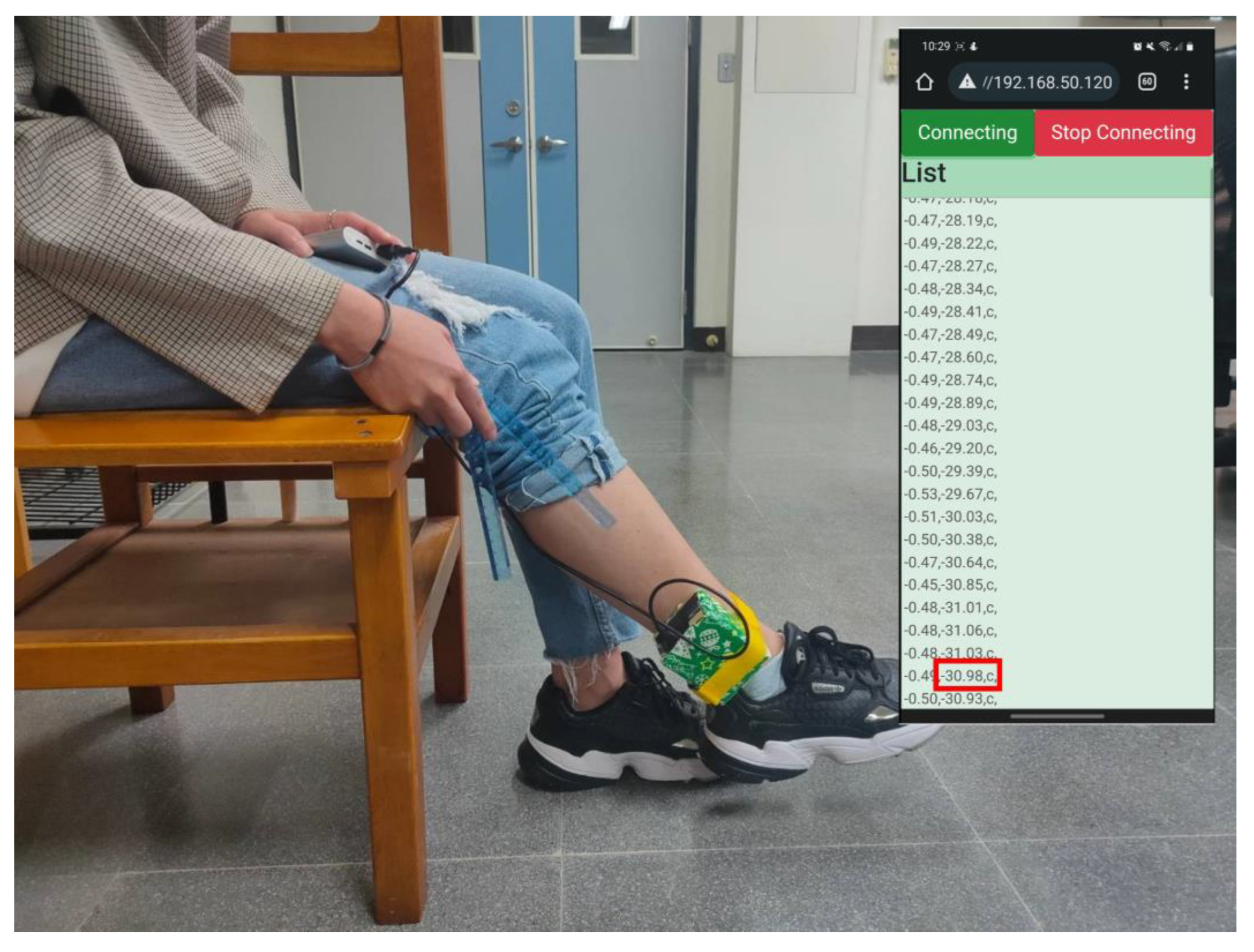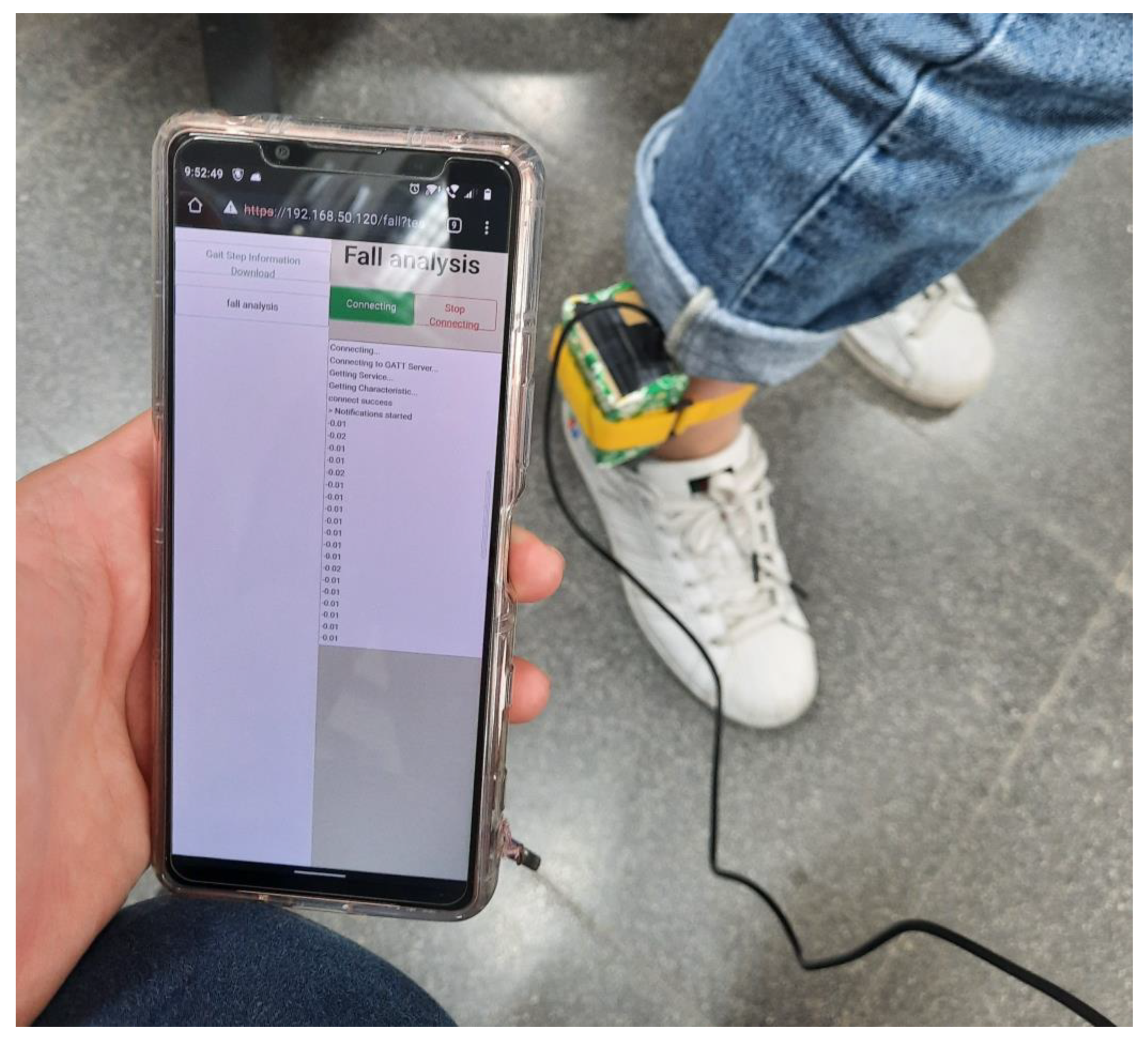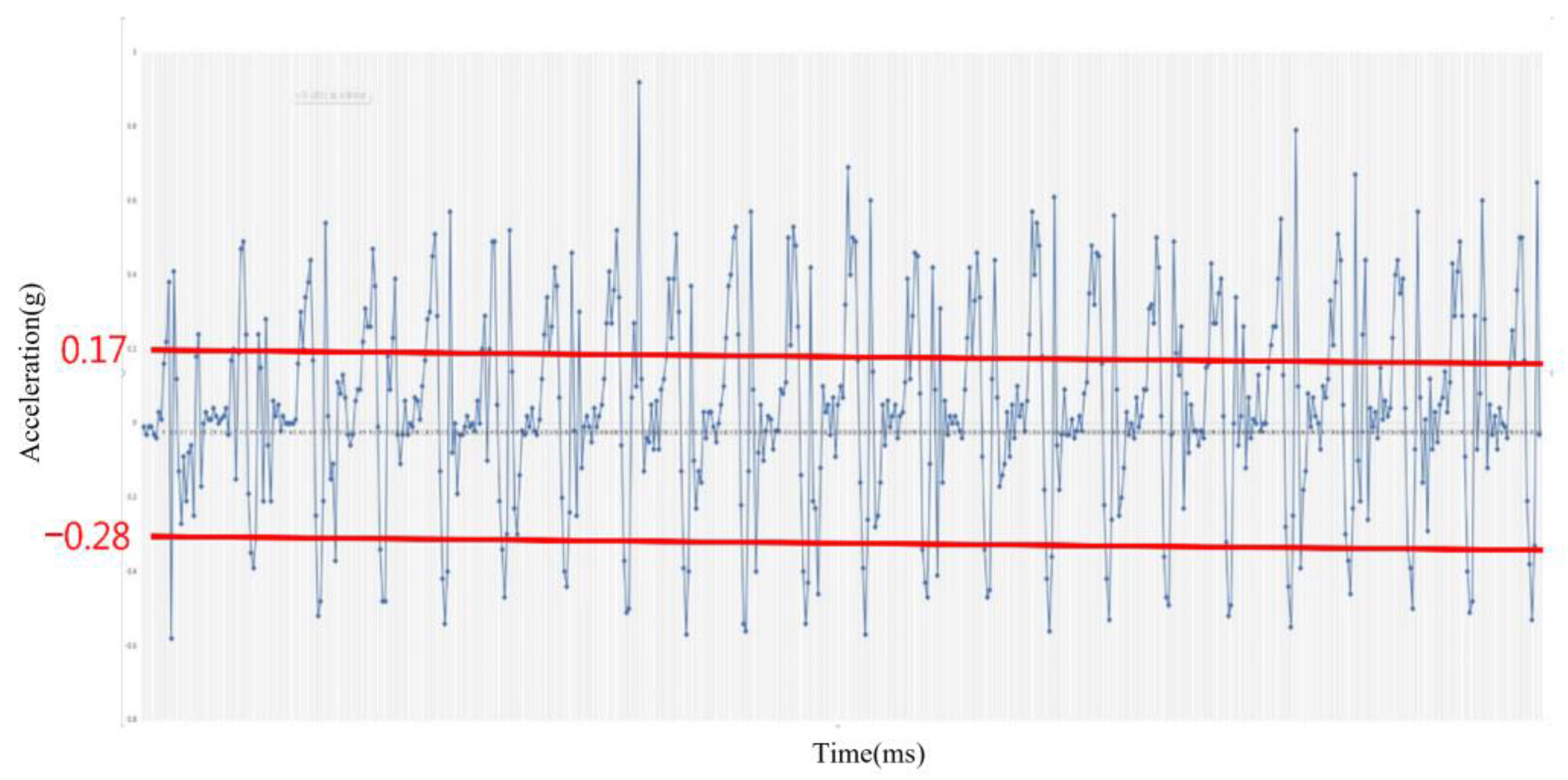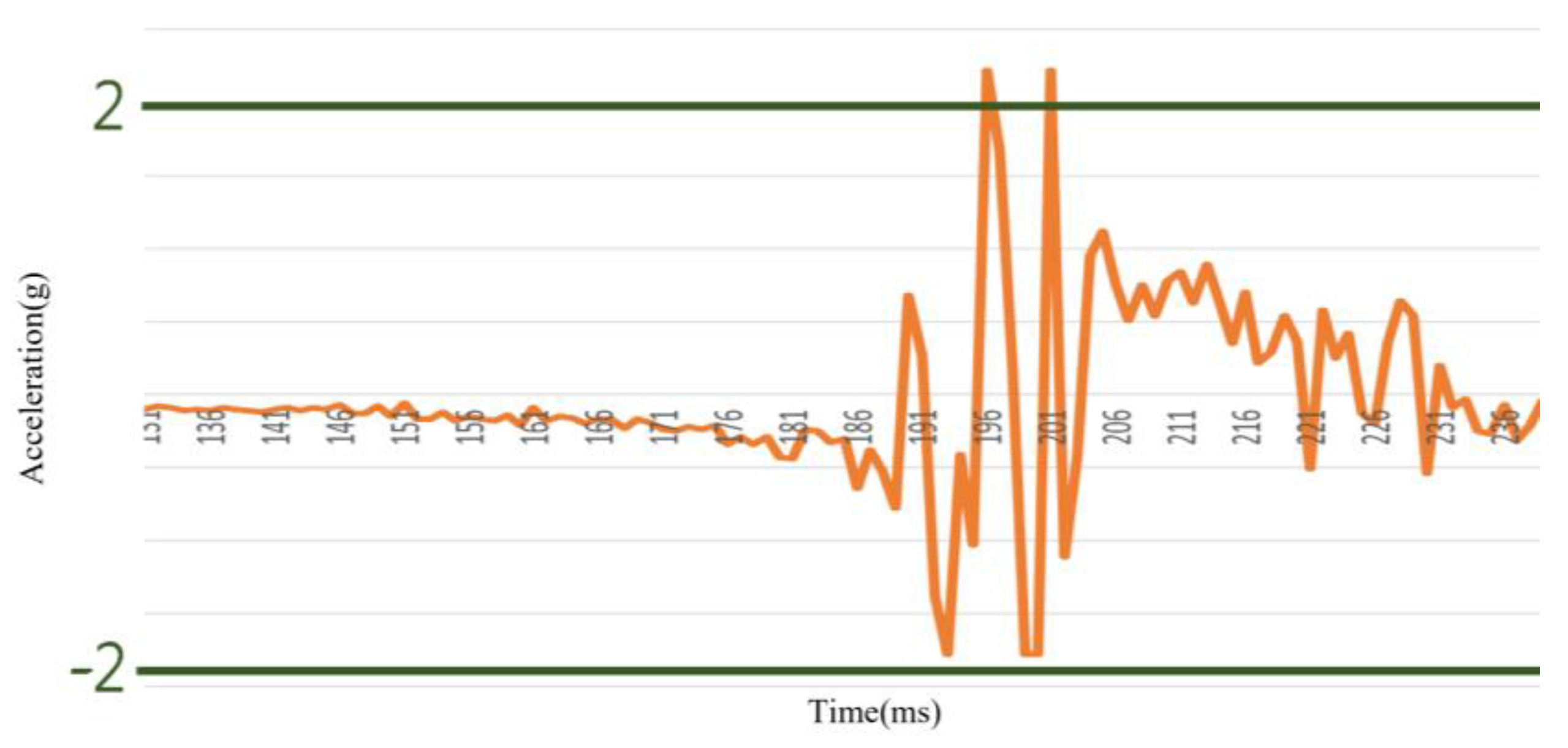1. Introduction
In Taiwan, an analysis report from the Health Promotion Administration, HPA, showed that the rehabilitation treatment is more important in modern medicine. It also showed that the fall accident becomes the second accident among all accidents for the elders more than sixty-five years in Taiwan due to significant decline for controlling and balancing muscle, such as gait analysis [
1,
2,
3,
4,
5].
In Ref. [
6], it developed a wearable Freezing of Gait (FOG) collection device for wavelet analysis on shank sagittal velocity signals and a synchronization of loss threshold (SLT) for prediction of FOG in people with Parkinson’s Disease (PD).
In Ref. [
7], it proposed a wearable foot gait collection device with step direction algorithm for motion state and direction of feet exercising. By using this wearable device, the burnt calories could be calculated. The health state of user also could be observed at any time and place by using this wearable foot gait collection device.
In Ref. [
8], a piecewise linear labeling was proposed to calculate the angular positions and velocities of thigh and torso segments as the training model data based on the variable toe-off onset with different walking speed. By the proposed piecewise linear labeling, the speed adaptability of gait phase estimation could be improved. Estimation accuracy of gait phase could be improved.
In Ref. [
9], it showed that the risk of fatal falls for elderly people is getting important. The Centers for Disease Control and Prevention (CDC) also showed that the serious injuries of elderly people may be occurred even if the falling is innocent. Hence, a system with wearable fall detection devices for tracking patient’s whole activity by accelerometer sensors was proposed. The patient’s predetermined alert could be identified and the corresponding alerts could be sent to the patients. Devices for tracking motion with high performance, low power, and low cost included the smart wearable sensors. Data could be decided based on data processing unit.
In Ref. [
10], it showed that the fatality may be occurred by fall, especially for elderly people who live alone. Hence, this paper aimed to detect fall by supervised machine learning (ML) algorithms, such as decision tree (DT), k-Nearest Neighbour (k-NN), and support vector machine (SVM). The experimental results showed that the sensitivity and accuracy of DT is better than
those of k-NN and SVM.
In Ref. [
11], it addressed the necessity of human fall elements by wearable devices regrading falls included signals acquired, features extracted, and algorithms, jointly. In Ref. [
12], it proposed a new data augmentation application for different rotation errors in wearable fall detection sensors.
The above mention showed the importance of gait analysis and fall detection. Most of gait analysis was suggested to be executed in any place, such as home, by medical staff to save time and money for patients. Although the gait analysis at home could reduce the time, money, and manpower for patients and medical institutions, how to ensure the motion of gait analysis is correct becomes the first important issue without any medical staff. Moreover, how to upload the data of gait analysis to cloud database and detect the fall accident in real time by APP was another issue.
A cross-platform gait analysis and fall detection wearable device (CPGAFDWD) was thus proposed firstly in this paper. Most of wearable devices were used by APP in mobile device, such as mobile phone. Since the platform of mobile phone may be different, such as iOS and Android, to ensure the APP we designed could be applied for different kinds of platforms is needed. Hence, a cross-platform APP was proposed to be integrated for CPGAFDWD in this paper.
Therefore, a cross-platform gait analysis and fall detection wearable device (CPGAFDWD) was proposed to address the above issues in this paper. The architecture of CPGAFDWD was shown in
Figure 1. The user interface of cross-platform APP was shown in
Figure 2.
In CPGAFDWD, the development board was used as Arduino board. The sensing modules, such as gyroscope and three-axis accelerometer, were used. The communication modules, such as Bluetooth and WiFi, were used. CPGAFDWD was integrated the Arduino board with the gyroscope, three-axis accelerometer, Bluetooth, and WiFi to detect the gait analysis and fall accident. The sensed data of gait analysis and fall accident from CPGAFDWD were transmitted to APP in real time.
CPGAFDWD collected the sensed data via Bluetooth immediately. Then CPGAFDWD uploaded these data to cloud database called MongoDB, via WiFi or 4G in real time. In CPGAFDWD, a web APP was designed by Node.js. Since web APP was used by browser without constraining to any platform, CPGAFDWD could be used in multi-platform of mobile phone. The users could track the status of gait analysis and receive the alarm of fall accident by CPGAFDWD.
The experiments of gait analysis included the step, length, and angle of pace. In ths statistical treatment with relevant comparisons, our pace step measurement was compared with the actual pace step of laboratory members on walking. Our pace angle measurement was compared with the actual pace angle of laboratory members by using protractor. For the fall detection, it was compared with the actual fall simulated by laboratory members. The experimental results showed that the rate of correct pace step measurement, the rate of correct pace length measurement, and the rate of correct pace angle measurement all could be up to 90%. For the fall detection, the experimental results showed that the detection rate of fall accident could be up to 100%. In the above results, it proved that CPGAFDWD could be applied for gait analysis and fall detection applications.
In CPGAFDWD, the experimental results showed that the user could track the status of gait analysis and receive the alarm of fall accident via the Internet in real time. Moreover, the above results were used in both of iOS and Android to prove that CPGAFDWD could be applied in cross-platform of mobile phone.
The remainder of this paper was arranged in the following sections.
Section 2 presented the related work.
Section 3 stated our proposed CPGAFDWD.
Section 4 stated our experimental results.
Section 5 showed the discussion. Finally,
Section 6 concluded this paper.
2. Related Work
In Refs. [
1,
2], it described the importance of fall detection for elders due to deterioration of foot function. To address this issue, a wearable device composed of three-axis accelerometer, gyroscope, and GPS was designed. Hence, the date time and location of fall could be detected by this wearable device.
A multi-condition adaptive step detection algorithm was proposed to improve the pedestrian dead reckoning system for increasing the measurement precision of the stride, step, and heading better than the existed traditional algorithms [
3].
In Ref. [
4], a linear mixed model was used to determine differences between spatial gait and non-motor symptoms, such as freezing in the levodopa-medicated-state (ON-state) called Parkinson’s disease. The levodopa-medicated-state was divided into non-freezers, freezing with only OFF-levodopa, and freezing with both ON- and OFF-levodopa. The experimental results proved that the variability for intra-patient in spatial gait features in ONOFF-FOG was much higher than those in others.
In Ref. [
5], the rehabilitation of balance and gait between sensory retraining (ESR) and implicit repeated exposure (IRE) was evaluated, such as balance, mobility, assessed sensation, and participation. It showed that both of ESR and IRE are all prone to implement for outpatient clinic.
In Ref. [
13], it compared the traditional approaches with inertial sensors for the measurement of hip and knee osteoarthritis in remote health care. It showed that the inertial sensors are more suitable for remote health care with extremity osteoarthritis.
The generalizability of deep learning models for predicting outdoor irregular walking surfaces was proposed to show that the results of laboratory-based gait analysis could not be used in real situation. Although the inertial measurement units may be used for real situation, the gait analysis may be still inaccurate since the behavior of walking was more complex in real world. Hence, this paper evaluated the surface classification performance with different data splitting, sensor location, and count by different machine learning models [
14].
In the above motion, it showed that the inertial measurement was often used in real situation for gait analysis. It also showed the importance of gait analysis and fall detection. However, none of them could measure the step count, step length, and angle of knee joint measurements with fall detection. Moreover, the wearable with cross-platform APP was not addressed since the cross-platform APP was required recently, such as Android and iOS. Therefore, a cross-platform gait analysis and fall detection wearable device (CPGAFDWD) was proposed to address these issues in this paper.
4. Results
To avoid the ethical permission in our experiment, the experimental results were executed by the laboratory members not the real patients and the wearable device should be attached at the ankle [
17,
18,
19,
20,
21,
22,
23,
24,
25]. The number of laboratory members was more than 20. In the step count (
SC), the range of acceleration value was calculated by the first quartile and third quartile values based on quartile method firstly [
17,
18,
19]. After excluding outlier value, the range of acceleration was calculated from −0.28 to 0.17, as shown in
Figure 14. Once the value of acceleration was between −0.28 and 0.17, the step count was increased by 1. It showed that the cross-platform gait analysis and fall detection wearable device (CPGAFDWD) we proposed could calculate the step count (
SC), accurately. The units of measurement along the x-axes of
Figure 14 was microsecond. The units of measurement along the y-axes of
Figure 14 was the
y value of three-axis acceleration.
The step distance (
SD) was calculated by the maximal and minimal acceleration values of one step count with 4th root calculation as in Equation (1), where
Amax and
Amin were denoted as the maximal and minimal acceleration values, and
n was denoted as the total step count [
20].
The fall detection (
FD) was determined by the maximal and minimal acceleration values. After the experimental results executed by the laboratory members with the wearable device we designed at the ankle, the maximal and minimal acceleration values were −2 and 2. Once the value of acceleration was below −2 or over 2, the alarm of
FD was triggered. As shown in
Figure 15, the value of acceleration from time unit 191 to 210 was below −2 or over 2. In this situation, the alarm of
FD was triggered. It proved that CPGAFDWD could detect the fall detection (
FD), accurately.
The accurate rate of
SC,
ARSC, was defined as in Equation (2), where
was defined as the number of detected
SC and
was defined as the number of actual correct
SC. The error rate of
SD,
ERSD, was defined as in Equation (3), where
was defined as the number of detected
SD and
was defined as the number of actual correct
SD. The accurate rate of angle estimation,
ARAngle, was defined as in Equation (4), where
was defined as the number of angle estimation and
was defined as the number of actual angle. The accurate rate of
FD,
ARFD, was defined as in Equation (5), where
was defined as the number of detected
FD and
was defined as the number of actual correct
FD. In each performance metric, such as
ARSC,
ERSD,
ARAngle, and
ARFD, was 20 times in a round. Each experimental result was 10 rounds. Hence, it showed that CPGAFDWD we proposed could calculate the angle, accurately. Moreover, it also showed that CPGAFDWD we proposed could detect the fall, accurately.
In the experimental results, the units of measurement along the x-axes of
Figure 15 was microsecond. The units of measurement along the y-axes of
Figure 15 was the
y value of three-axis acceleration. It showed that
ARSC was up to 92%, 95%, and 89%, while
was 10, 15, and 20, respectively. The average
ARSC by CPGAFDWD was higher than the average
ARSC by SVM step classifier [
7,
20].
ERSD was up to 4%, 8%, and 4%, while
was 10, 15, and 20, respectively. The average
ERSD was below 6%.
ARAngle was up to 92%, 95%, and 95%, while
was 30, 60, and 90, respectively. The average
ARAngle was up to 92%.
ERSD was up to 100%, where
was set to 500 and
was set to 10 in each round. The average
ARFD was up to 90%.
5. Discussion
In this section, it focused on Cross-Platform APP, CPAPP, such as the different user interfaces and the corresponding functions, firstly. The login of CPAPP in both of iOS and Android was showed in
Figure 3. The measurement of pace step in both of iOS and Android was showed in
Figure 6 and
Figure 7. The measurement of pace length in both of iOS and Android was showed in
Figure 8 and
Figure 9. The measurement of pace angle in both of iOS and Android was showed in
Figure 10 and
Figure 11. the measurement of fall detection was showed in
Figure 12 and
Figure 13. In
Figure 6,
Figure 7,
Figure 8,
Figure 9,
Figure 10,
Figure 11,
Figure 12 and
Figure 13, it proved that CPAPP designed in this paper could be applied for cross-platform of mobile device, such as Android and iOS.
The basis of reported percentages was calculated based on Equations (1)–(5) and the experimental results were obtained by laboratory members on walking and falling. In the experimental result of gait analysis and fall detection wearable device, GAFDWD,
ARSC,
ERSD,
ARAngle, and
ARFD were the performance metrics.
ARSC was up to 92%, 95%, and 89%, while
was 10, 15, and 20, respectively. In Refs. [
7,
20], it used SVM to classify in the walking gait test by a wearable foot gait collection device with step direction algorithm at any time and place as same as our GAFDWD. The experimental results showed that the accuracy rate of SVM is 86%, and only 86 steps are judged for every 100 steps. However, our GAFDWD in walking gait accuracy could reach about 90%.
The average
ARSC by CPGAFDWD was higher than the average
ARSC by SVM step classifier [
7,
20].
ERSD was up to 4%, 8%, and 4%, while
was 10, 15, and 20, respectively. The average
ERSD was below 6%.
ARAngle was up to 92%, 95%, and 95%, while
was 30, 60, and 90, respectively. The average
ERSD was below 6% and the average
ARAngle was up to 92%.
ERSD was up to 100%, where
was set to 500 and
was set to 10 in each round.The minimum
ERSD was 4% and the maximal
ARAngle was up to 95%. The average
ARFD was up to 90%.
The above results showed that the cross-platform gait analysis and fall detection wearable device (CPGAFDWD) proposed in this paper could be applied for gait analysis and fall detection and also could be applied for cross-platform mobile devices. In the future work, the accuracy will be improved in clinical work in the later stage.
6. Conclusions
Due to the progress in medical technology and the advent of an aging society, the rehabilitation treatment gets attention gradually. The rehabilitation methods are different according to different parts of the body and symptoms.
In this paper, it focused on gait analysis, such as step count, step length, and angle of knee joint measurements, since the gait analysis was often needed for elderly. In addition to gait analysis, fall accident was also often occurred for elderly.
In the above mention, it showed the importance for gait analysis and fall detection in modern rehabilitation medicine. However, the existed gait analysis in hospital was still executed by specific medical instruments. In this way, the time and money for patients must increase. The feasibility of gait analysis thus decreased, since the gait analysis could not be executed in any place and any time. For medical institutions, the manpower also increased.
Hence, how to ensure that gait analysis could be executed in any place and any time becomes an important issue. However, how to ensure that the gait analysis was correct at home becomes another important issue, since the incorrect gait analysis may lead to incorrect rehabilitation. The rehabilitation treatments may be discounted.
Therefore, a cross-platform gait analysis and fall detection wearable device, CPGAFDWD, was proposed to address the above issues in this paper. In CPGAFDWD, it aimed to ensure that the gait analysis could be correct without limiting to any time and place for patients. The experimental results also showed that the correct rate of gait analysis was over 90% and the correct rate of fall detection was close to 100%. It proved that CPGAFDWD we proposed could be applied for gait analysis and fall detection in any time and place. The time, money, and manpower thus could be reduced for patients and medical institutions. In the future, we will apply IRB for CPGAFDWD used in clinical medicine.

